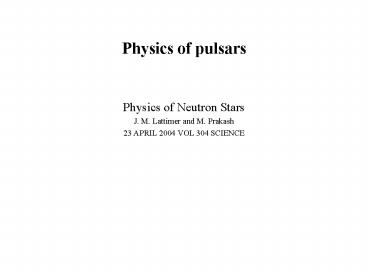Physics of pulsars - PowerPoint PPT Presentation
1 / 27
Title:
Physics of pulsars
Description:
... densities, exotica such as strangeness-bearing baryons, condensed mesons (pion ... up, down, and strange quarks (the charm, bottom, and top quarks are too massive ... – PowerPoint PPT presentation
Number of Views:30
Avg rating:3.0/5.0
Title: Physics of pulsars
1
Physics of pulsars
- Physics of Neutron Stars
- J. M. Lattimer and M. Prakash
- 23 APRIL 2004 VOL 304 SCIENCE
2
Introductions
- Dentist and Smallest stars.
- Combination of nuclear physics, particle physics,
condense matter physics and astrophysics - hyperon-dominated matter, de-confined quark
matter, superfluidity and superconductivity with
critical temperatures near 1010 k - Opaqueness to neutrinos, and magnetic fields in
excess of 1013 Gauss
3
(No Transcript)
4
(No Transcript)
5
Brief History of the discovery
- Chadwicks discovery of the neutron
- The prediction that matter at the almost
unimaginable density of 1018 kg/m3 - might be formed under gravitational compression
inside stars was first made by Baade and Zwicky
in 1934 - Many theoretical approach to the properties of
the Neutron Stars - Discovery of 4 pulsars in 1967
6
Composition of NS
- A central density nc as high as 5 to 10 times the
nuclear equilibrium density n0 0.16 fm-3 of
neutrons and protons found in laboratory nuclei - Although neutrons dominate the nucleonic
component, some protons (and enough electrons and
muons to neutralize the matter) exist - At supranuclear densities, exotica such as
strangeness-bearing baryons, condensed mesons
(pion or kaon) or even deconfined quarks may
appear.
7
SQM Stars
- 1. bare quark-matter surface with a large,
supranuclear density - 2. thin layer of normal matter supported by
Coulomb forces above the quark surface - up, down, and strange quarks (the charm, bottom,
and top quarks are too massive to appear inside
pulsars). Unlike normal stars, SQM stars are
self-bound, not requiring gravity to hold them
together.
8
How Neutron Stars are Formed
- massive star 8 MT Collapse.
- Type II SNe
- Gravitational binding energy released from a WD
core to a NS 3GM/5R2 1053 erg, which is about
10 of its total mass energy Mc2 - The kinetic energy of the expanding remnant 1051
erg, and the total energy radiated in photons is
further reduced. - When n 2 to 3 n0 , a mean free path for
neutrino is 10 cm, much less than the radius of
proto-neutron star, 20 km.
9
Shock wave
- Core collapse halts when the stars interior
density reaches n0, which triggers the formation
of a shock wave at the cores outer edge - The shock wave propagates only about 100 to 200
km before it stalls - Neutrinos resuscitate the shock
- The protoneutron rapidly shrinks because of
pressure losses from neutrino emission - The escape of neutrinos occurs on a time scale of
10 s
10
(No Transcript)
11
Global Structure of Neutron Stars
- mass-radius (M-R) relation are determined by the
equations of hydrostatic equilibrium - TOV and EOS (equation of state)
12
Is SAX J1808.4-3658 a Strange Star?(Li et al.
1999)
13
A simultaneous measurementof mass and radius
could help to discriminate EOSs
14
Difference of EOSs
- GS1, contain large amounts of exotica, any of
which produces a large amount of softening and
relatively small radii and maximum masses - For normal neutron stars, the radius is
relatively insensitive to the mass in the
vicinity of 1 to 1.5 MT - Perhaps two of the most important, but unknown,
astrophysical quantities are the neutron star
maximum mass and the radius of 1.4 MJ neutron
stars
15
A simultaneous measurementof mass and radius
could help to discriminate EOSs
16
Uncertainties in EOSs
- large variations in predicted radii and maximum
masses because of the uncertainties in the EOS
near and above n0 - an important distinction between nuclear and
neutron star matter is their relative proton
fraction x
17
(No Transcript)
18
Layers structure
- Atmosphere plays an important role in shaping
the photon spectrum - Envelope crucially influences the transport and
release of thermal energy from the stars surface - Crust 1 to 2 km, primarily contains nuclei. at
densities above the neutron drip density,
neutrons leak out of nuclei. - Outer core neutron 3P2 superfluid and the
protons 1S0 superconductor - Inner core a mixed phase of hadronic and
deconfined quark matter, even if strange quark
matter is not the ultimate ground state of matter
19
How to distinguish EOSs?
- The missing information
20
The spin up of a pulsar in the binary system
- Accretion phase, accretion extend to the surface
of the pulsar.
21
Variation in the rotation inertia should not be
ignored
22
(No Transcript)
23
(No Transcript)
24
SAX J1808.4-3658
25
Her X-1
26
2A 1822-371
27
application
- A method to determine the EOS of pulsar in binary
systems. - Constraint the theoretical particle physics
- Predict the observational timing feature of the
SQM stars































